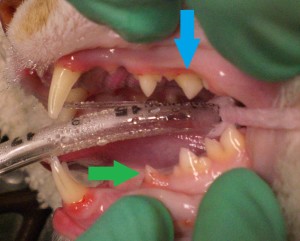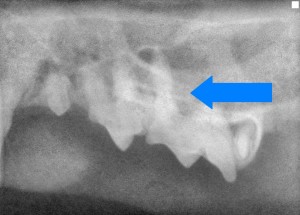Did you know cats can get cavities? Well, technically it is tooth resorption, not the same type of cavities that people get. But it does involve destruction of the protective lining of the tooth and exposure of the sensitive pulp chamber, creating a very painful tooth and potentially infection. The proper term for this type of cavity is Feline Odontoclastic Resorptive Lesion, or FORL for short. No one is quite sure what causes it. But it is painful and it does require tooth extraction to make your cat more comfortable.
How do you know if your cat has one? Short of opening the mouth and looking for them, it can be difficult to tell, because many cats show no symptoms at all. Some cats will show signs such as excessive salivation, chewing their food only on one side of the mouth (avoiding the painful side) or only eating canned food. There could be some bleeding from the bad tooth, and sometimes they will show pain or chatter their jaw when the affected tooth is touched. Some cats just hide more often, and may become less social or more grumpy. Unfortunately that type of response is often overlooked, or written off as “old age”.
What does it look like? Here is a picture from a cat that recently had a dental cleaning:
Note how the gums appear to have grown up over the tooth (green arrow). This is the body’s way of protecting the hole in the tooth. The rest of the teeth look normal and healthy, but keep reading and we will show you why the tooth with the blue arrow is not ok!
Here is the radiograph of the mandibular premolars (bottom teeth). You can see the affected tooth (green arrow) looks moth-eaten compared to the healthy tooth right next to it.
Here is a radiograph of the maxillary premolars (top teeth) of the same cat, same side of the mouth.
In the picture above, the tooth with the blue arrow looks completely normal. However this radiograph shows a FORL on one of its roots (blue arrow) which makes it look like there is a bite out of both sides of it. People with these types of lesions on their roots say that they are not painful, but once the lesion reaches the gumline they do become painful. Unfortunately there is no way to predict how quickly this will happen. We decided to extract this tooth before it became painful.
So the moral of the story is to make sure to have your cat examined by a veterinarian at least once a year so your vet can hopefully spot these lesions and alert you to them. Pay attention to your cat’s oral health, and provide dental chews or brush her teeth. Check out VOHC.org for a list of products proven to improve oral health in dogs and cats. Getting your cat’s teeth cleaned under anesthesia will help prevent tooth loss and dental radiographs can catch potential lesions before they become a problem.





